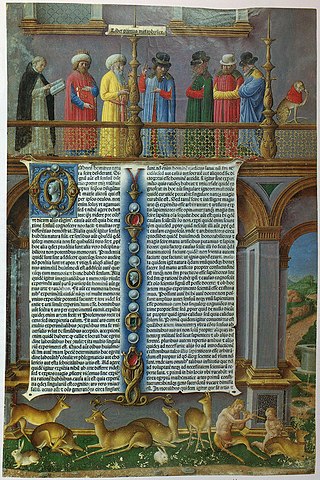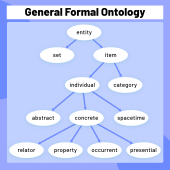Abstraction is a process wherein general rules and concepts are derived from the usage and classification of specific examples, literal signifiers, first principles, or other methods.

A concept is defined as an abstract idea. It is understood to be a fundamental building block underlying principles, thoughts, and beliefs. Concepts play an important role in all aspects of cognition. As such, concepts are studied within such disciplines as linguistics, psychology, and philosophy, and these disciplines are interested in the logical and psychological structure of concepts, and how they are put together to form thoughts and sentences. The study of concepts has served as an important flagship of an emerging interdisciplinary approach, cognitive science.

Existence is the state of having being or reality in contrast to nonexistence and nonbeing. Existence is often contrasted with essence: the essence of an entity is its essential features or qualities, which can be understood even if one does not know whether the entity exists.

Metaphysics is the branch of philosophy that examines the basic structure of reality. It is often characterized as first philosophy, implying that it is more fundamental than other forms of philosophical inquiry. Metaphysics is traditionally seen as the study of mind-independent features of the world, but some modern theorists understand it as an inquiry into the conceptual schemes that underlie human thought and experience.

In metaphysics, nominalism is the view that universals and abstract objects do not actually exist other than being merely names or labels. There are at least two main versions of nominalism. One version denies the existence of universals – things that can be instantiated or exemplified by many particular things. The other version specifically denies the existence of abstract objects – objects that do not exist in space and time.
Ontology is the philosophical study of being. As one of the most fundamental concepts, being encompasses all of reality and every entity within it. To articulate the basic structure of being, ontology examines what all entities have in common and how they are divided into fundamental classes, known as categories. An influential distinction is between particular and universal entities. Particulars are unique, non-repeatable entities, like the person Socrates. Universals are general, repeatable entities, like the color green. Another contrast is between concrete objects existing in space and time, like a tree, and abstract objects existing outside space and time, like the number 7. Systems of categories aim to provide a comprehensive inventory of reality, employing categories such as substance, property, relation, state of affairs, and event.
Substance theory, or substance–attribute theory, is an ontological theory positing that objects are constituted each by a substance and properties borne by the substance but distinct from it. In this role, a substance can be referred to as a substratum or a thing-in-itself. Substances are particulars that are ontologically independent: they are able to exist all by themselves. Another defining feature often attributed to substances is their ability to undergo changes. Changes involve something existing before, during and after the change. They can be described in terms of a persisting substance gaining or losing properties. Attributes or properties, on the other hand, are entities that can be exemplified by substances. Properties characterize their bearers; they express what their bearer is like.
Mereology is the philosophical study of part-whole relationships, also called parthood relationships. As a branch of metaphysics, mereology examines the connections between parts and their wholes, exploring how components interact within a system. This theory has roots in ancient philosophy, with significant contributions from Plato, Aristotle, and later, medieval and Renaissance thinkers like Thomas Aquinas and John Duns Scotus. Mereology gained formal recognition in the 20th century through the pioneering works of Polish logician Stanisław Leśniewski, who introduced it as part of a comprehensive framework for logic and mathematics, and coined the word "mereology". The field has since evolved to encompass a variety of applications in ontology, natural language semantics, and the cognitive sciences, influencing our understanding of structures ranging from linguistic constructs to biological systems.
In metaphysics, the distinction between abstract and concrete refers to a divide between two types of entities. Many philosophers hold that this difference has fundamental metaphysical significance. Examples of concrete objects include plants, human beings and planets while things like numbers, sets and propositions are abstract objects. There is no general consensus as to what the characteristic marks of concreteness and abstractness are. Popular suggestions include defining the distinction in terms of the difference between (1) existence inside or outside space-time, (2) having causes and effects or not, (3) having contingent or necessary existence, (4) being particular or universal and (5) belonging to either the physical or the mental realm or to neither. Despite this diversity of views, there is broad agreement concerning most objects as to whether they are abstract or concrete. So under most interpretations, all these views would agree that, for example, plants are concrete objects while numbers are abstract objects.
Quantity or amount is a property that can exist as a multitude or magnitude, which illustrate discontinuity and continuity. Quantities can be compared in terms of "more", "less", or "equal", or by assigning a numerical value multiple of a unit of measurement. Mass, time, distance, heat, and angle are among the familiar examples of quantitative properties.
In information science, an upper ontology is an ontology that consists of very general terms that are common across all domains. An important function of an upper ontology is to support broad semantic interoperability among a large number of domain-specific ontologies by providing a common starting point for the formulation of definitions. Terms in the domain ontology are ranked under the terms in the upper ontology, e.g., the upper ontology classes are superclasses or supersets of all the classes in the domain ontologies.
In philosophy, the term formal ontology is used to refer to an ontology defined by axioms in a formal language with the goal to provide an unbiased view on reality, which can help the modeler of domain- or application-specific ontologies to avoid possibly erroneous ontological assumptions encountered in modeling large-scale ontologies.
Trope denotes figurative and metaphorical language and one which has been used in various technical senses. The term trope derives from the Greek τρόπος (tropos), "a turn, a change", related to the root of the verb τρέπειν (trepein), "to turn, to direct, to alter, to change"; this means that the term is used metaphorically to denote, among other things, metaphorical language.

Moderate realism is a position in the debate on the metaphysics of universals associated with the hylomorphic substance theory of Aristotle. There is no separate realm in which universals exist, nor do they really exist within particulars as universals, but rather universals really exist within particulars as particularised, and multiplied.
The following outline is provided as an overview of and topical guide to metaphysics:
In philosophy, a process ontology refers to a universal model of the structure of the world as an ordered wholeness. Such ontologies are fundamental ontologies, in contrast to the so-called applied ontologies. Fundamental ontologies do not claim to be accessible to any empirical proof in itself but to be a structural design pattern, out of which empirical phenomena can be explained and put together consistently. Throughout Western history, the dominating fundamental ontology is the so-called substance theory. However, fundamental process ontologies have become more important in recent times, because the progress in the discovery of the foundations of physics has spurred the development of a basic concept able to integrate such boundary notions as "energy," "object", and those of the physical dimensions of space and time.
Structuralism is a theory in the philosophy of mathematics that holds that mathematical theories describe structures of mathematical objects. Mathematical objects are exhaustively defined by their place in such structures. Consequently, structuralism maintains that mathematical objects do not possess any intrinsic properties but are defined by their external relations in a system. For instance, structuralism holds that the number 1 is exhaustively defined by being the successor of 0 in the structure of the theory of natural numbers. By generalization of this example, any natural number is defined by its respective place in that theory. Other examples of mathematical objects might include lines and planes in geometry, or elements and operations in abstract algebra.

Relations are ways in which several entities stand to each other. They usually connect distinct entities but some associate an entity with itself. The adicity of a relation is the number of entities it connects. The direction of a relation is the order in which the elements are related to each other. The converse of a relation carries the same information and has the opposite direction, like the contrast between "two is less than five" and "five is greater than two". Both relations and properties express features in reality with a key difference being that relations apply to several entities while properties belong to a single entity.
In the philosophy of mathematics, Aristotelian realism holds that mathematics studies properties such as symmetry, continuity and order that can be immanently realized in the physical world. It contrasts with Platonism in holding that the objects of mathematics, such as numbers, do not exist in an "abstract" world but can be physically realized. It contrasts with nominalism, fictionalism, and logicism in holding that mathematics is not about mere names or methods of inference or calculation but about certain real aspects of the world.






